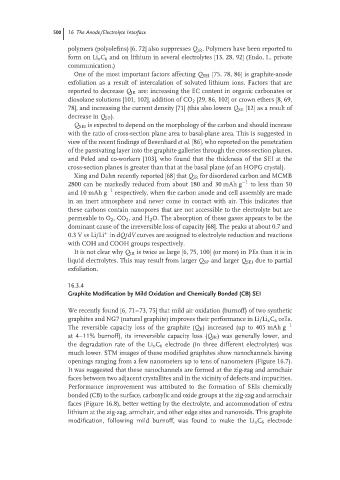Page 527 - Handbook of Battery Materials
P. 527
500 16 The Anode/Electrolyte Interface
polymers (polyolefins) [6, 72] also suppresses Q IR . Polymers have been reported to
form on Li x C 6 and on lithium in several electrolytes [13, 28, 92] (Endo, I., private
communication.)
One of the most important factors affecting Q SEI [75, 78, 86] is graphite-anode
exfoliation as a result of intercalation of solvated lithium ions. Factors that are
reported to decrease Q IR are: increasing the EC content in organic carbonates or
dioxolane solutions [101, 102], addition of CO 2 [29, 86, 102] or crown ethers [8, 69,
78], and increasing the current density [71] (this also lowers Q SE [12] as a result of
decrease in Q SP ).
Q SEI is expected to depend on the morphology of the carbon and should increase
with the ratio of cross-section plane area to basal-plane area. This is suggested in
view of the recent findings of Besenhard et al. [86], who reported on the penetration
of the passivating layer into the graphite galleries through the cross-section planes,
and Peled and co-workers [103], who found that the thickness of the SEI at the
cross-section planes is greater than that at the basal plane (of an HOPG crystal).
Xing and Dahn recently reported [68] that Q IR for disordered carbon and MCMB
2800 can be markedly reduced from about 180 and 30 mAh g −1 to less than 50
and 10 mAh g −1 respectively, when the carbon anode and cell assembly are made
in an inert atmosphere and never come in contact with air. This indicates that
these carbons contain nanopores that are not accessible to the electrolyte but are
permeable to O 2 ,CO 2 ,and H 2 O. The absorption of these gases appears to be the
dominant cause of the irreversible loss of capacity [68]. The peaks at about 0.7 and
0.3 V vs Li/Li in dQ/dV curves are assigned to electrolyte reduction and reactions
+
with COH and COOH groups respectively.
It is not clear why Q IR is twice as large [6, 75, 100] (or more) in PEs than it is in
liquid electrolytes. This may result from larger Q SP and larger Q SEI due to partial
exfoliation.
16.3.4
Graphite Modification by Mild Oxidation and Chemically Bonded (CB) SEI
We recently found [6, 71–73, 75] that mild air oxidation (burnoff) of two synthetic
graphites and NG7 (natural graphite) improves their performance in Li/Li x C 6 cells.
−1
The reversible capacity loss of the graphite (Q R ) increased (up to 405 mAh g
at 4–11% burnoff), its irreversible capacity loss (Q IR ) was generally lower, and
the degradation rate of the Li x C 6 electrode (in three different electrolytes) was
much lower. STM images of these modified graphites show nanochannels having
openings ranging from a few nanometers up to tens of nanometers (Figure 16.7).
It was suggested that these nanochannels are formed at the zig-zag and armchair
faces between two adjacent crystallites and in the vicinity of defects and impurities.
Performance improvement was attributed to the formation of SEIs chemically
bonded (CB) to the surface, carboxylic and oxide groups at the zig-zag and armchair
faces (Figure 16.8), better wetting by the electrolyte, and accommodation of extra
lithium at the zig-zag, armchair, and other edge sites and nanovoids. This graphite
modification, following mild burnoff, was found to make the Li x C 6 electrode

